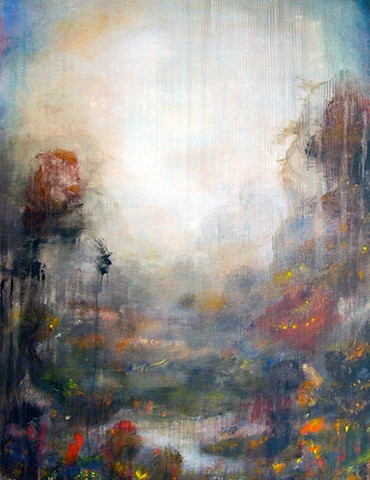Mark Emerson + Tom Leaver @ JayJay
Posted on Square Cylinder on 10 October 2014.
Over the past three decades Mark Emerson has refined a practice of combining bold colors and fractured shapes. His works consist of colliding vectors and kaleidoscopic voids that, when churned by a polyrhythmic approach to composition, cleave labyrinthine paths out of interpenetrating geometric forms. If that sounds complicated, well, it is. Its roots, traced backwards, run from Neo-Geo in the 1980s to hard edge abstraction at mid-century to Russian Constructivism in the teens.
Karl Benjamin (1925-2012), a key figure in the hard edge contingent, appears to be a touchstone. Had the two artists been friends they might have shared a credo: Eliminate illusionistic space to exaggerate the flux of geometric movement such that planar abstraction bends the space within the frame. The Shape of Rhythm – the latest of several Emerson exhibits to include the word rhythm in the title – does that and then some. Where I once thought Emerson’s approach formulaic, I now see that having perfected a method, he revels in the extremes to which it can be stretched. That elasticity has to do with the parsing of space, which like rhythm is infinitely divisible.
The breakout work in this series, Run, Hide, Fight, consists of 256 squares arrayed in a grid, each divided by other shapes whose names you’d need a geometry text to identify. They, in turn, combine to form six larger shapes that dominate the canvas, exerting Op-like force fields. Another noteworthy aspect of this painting is that each of the individual squares can be seen as standalone compositions, much like the abstract components of a Chuck Close portrait; only here they’re rendered in the blocky manner of Helen Lundberg (1908-1999), who, like Benjamin, may have at some point whispered across history into Emerson’s ear.
Toss and Turn and Green, Green push out in other directions. They appear as aerial views of farmland and subdivisions created out of digital noise: the wacky patterns that show up on your TV screen when the cable signal goes haywire. Though teeming with color, they are, by Emerson’s retina-challenging standards, quiet paintings. The rhythms — defined by tightly packed squares and rectangles aligned in vertical and horizontal swatches — make it appear as if the compositions (though not the paint handling) were machine-generated, without regard for visual hierarchy. The same qualities define Note for Note. It consists of horizontal bands of varying length stacked atop each other like snippets of encrypted code or an avant-garde musical score. This slowing of motion allows us to detect the contrasting surface textures, which can all too easily be overlooked in the frenzy of visual activity in almost everything Emerson does.
The remaining paintings in this series bear a closer resemblance to earlier works in which the aforementioned polyrhythms were more pronounced. Like those in Latin jazz, they interlock and drive forward, presenting disparate pieces as a unified whole. The best examples are Touch Points and Just Like You & Me: “action paintings” built not of bodily gestures, but of carefully apportioned geometric snippets – stolid shapes that, in Emerson’s handling, bend our perception of the space inside the frame.
Tom Leaver who paints in a style reminiscent of the Hudson River School joins Emerson in this exhibition. He creates boggy landscapes enshrouded in mist, oftentimes with streams burbling up the center out of blinding white horizons. They’re masterfully executed with a degree of smudgy abstraction that easily distinguishes him from his 19th century forbearers: Thomas Cole, Frederick Edwin Church and Albert Bierstadt. Contemporary interpretations of Romantic painting have lately spurred discussion of what Edmund
Burke’s ideas about the sublime might mean at a time when nature no longer has the power to shock and disarm. It’s a discussion worth having. Problem is, Leaver’s paintings don’t really engage it. Nor do they exhibit much variety; they tend, within each exhibition, to feature the same imagery over and over with only minor variations. To that, Leaver might respond as Johnny Cash’s legendary guitarist, Luther Perkins, did when asked why he kept repeating subtle variations of the same riff: “Those other guys runnin’ all up and down the neck — they’re still lookin’ for it. I found it.” In that regard, Leaver’s conviction is as unassailable as his paintings are ethereal and transporting.
–DAVID M. ROTH
Mark Emerson: “The Shape of Rhythm” + Tom Leaver: “Where” @ JayJay through October 25, 2014.



